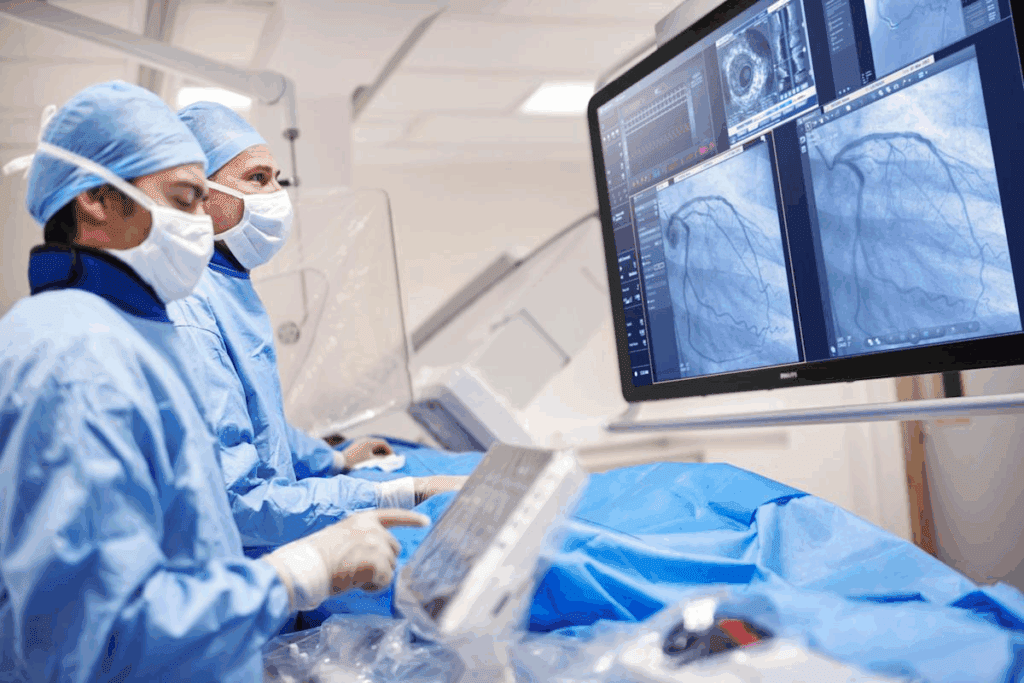Last Updated on October 31, 2025 by Batuhan Temel

The coronary arteries are key blood vessels. They carry oxygen-rich blood to the heart muscle. They wrap around the heart and go deep into its tissue. This is vital for keeping the heart healthy.Learn where is the coronary artery located and how it supplies blood to the heart.
At Liv Hospital, we know how important the coronary arteries are. They give the heart the oxygen and nutrients it needs. These arteries branch off first from the aorta, helping the heart’s layers work right.
It’s important to understand the role of coronary arteries in heart health. Problems with these arteries can cause serious heart issues. This shows why we need top-notch care and knowledge in heart anatomy.

The coronary circulation is key for the heart to work right. It makes sure the heart muscle gets the blood it needs. The coronary arteries, like the left main and right coronary arteries, branch into smaller vessels. These vessels, such as the Left Anterior Descending (LAD) and Left Circumflex (Cx) arteries, are vital for blood supply to the heart.
Coronary circulation is the network of blood vessels that feed and drain the heart. The name ‘coronary arteries’ comes from how they circle the heart like a crown. This system is vital because it brings oxygen and nutrients to the heart muscle. This lets the heart pump blood well throughout the body.
Without coronary circulation, the heart muscle wouldn’t get the nutrients and oxygen it needs. This could lead to angina and myocardial infarction.
Key aspects of coronary circulation include:
The heart is a muscular organ that works all the time. It needs a constant flow of oxygen and nutrients to function. The coronary arteries provide this by giving the heart muscle the blood it needs.
This is important because the heart can’t get its own blood supply from the blood it pumps. It needs its own vascular system to get oxygen and nutrients directly to its muscle cells.
The importance of the coronary blood supply can’t be stressed enough. Any problem with it can cause serious heart conditions. This shows how critical coronary arteries are for heart health.

The coronary arteries are key to the heart’s health. They bring blood to the heart. Knowing how they start and spread around the heart is vital.
The coronary arteries start at the aortic sinuses, at the aorta’s base. The left coronary artery (LCA) and the right coronary artery (RCA) begin from the left and right sinuses. The LCA splits into the left anterior descending artery (LAD) and the left circumflex artery (Cx). The RCA branches into the right marginal artery and the posterior descending artery.
A famous cardiologist says, “The coronary arteries are the heart’s lifeline. They give it oxygen and nutrients to work right.” This shows how important knowing the heart’s blood system is.
The coronary arteries spread blood across the heart. The LCA, through its branches (LAD and Cx), mainly feeds the left side. The LAD goes down the front, and the Cx goes around the back, covering the left ventricle and atrium.
The RCA, though, feeds the right side and the back of the heart. It goes to the right atrium, ventricle, and the back through the posterior descending artery. This pattern is key for the heart to get enough blood.
Knowing the coronary arterial system’s anatomy is essential. It helps in diagnosing and treating heart diseases.
The left main coronary artery is key to the left ventricle and atrium’s health. It’s a vital part of the heart’s blood system. It supplies blood to a big part of the heart.
The left main coronary artery starts at the aortic root, from the left aortic sinus. It goes between the left pulmonary trunk and the left auricle. This part is important for blood to reach the left heart.
It then splits into two main branches: the left anterior descending (LAD) artery and the circumflex branch. This split is key for blood to reach all parts of the left heart.
The left main coronary artery supplies a lot of the heart. Its branches, the LAD and circumflex, feed the left ventricle and parts of the left atrium. This ensures the left heart works well.
The lm heart artery is essential for the heart’s health. The areas it supplies are key for the heart’s pumping. Any problem with it can cause serious heart issues.
In short, the left main coronary artery is a vital part of the heart’s blood system. Its role in the heart’s health is clear from its location and how it supplies blood to different heart areas.
The Left Anterior Descending Artery (LAD) is a key part of the left coronary artery. It brings blood to the heart’s front side. This artery is vital for a big part of the heart’s front.
The LAD starts from the left coronary artery and goes down the front groove of the heart. It reaches the heart’s tip and then goes to the back. There, it connects with the posterior descending artery.
This path lets the LAD feed the front two-thirds of the heart’s wall. This area is key for the heart’s work.
The LAD feeds important parts of the heart, including:
These parts are vital for the heart’s pumping. Trouble with the LAD’s blood flow can harm the heart a lot. The LAD is key for keeping the heart’s front wall strong.
| Region Supplied | Significance |
| Anterior wall of the left ventricle | Critical for the heart’s pumping function |
| Anterior two-thirds of the interventricular septum | Essential for the separation of the ventricles |
| Apex of the heart | Important for the overall cardiac function |
The LAD is a main part of the heart’s blood flow. It supplies the front wall and the heart’s wall. This makes it very important for heart health.
“The LAD is often called the ‘widowmaker’ because it’s so important. If it gets blocked, it can cause serious problems.”
This shows how critical the LAD is in medicine. We need to be careful when dealing with it.
The left circumflex artery is key in supplying blood to the heart’s left side. It’s part of the coronary system, making sure the left ventricle and atrium get the oxygen and nutrients they need. We’ll dive into its path and how it distributes blood.
The left circumflex artery runs along the left atrioventricular groove. This path lets it feed the lateral and posterior walls of the left ventricle. It’s vital for the heart’s function, nourishing a big part of the left ventricle. The coronary circulation diagram shows how it wraps around the left heart.
The left circumflex artery has branches for the left ventricle and atrium. It includes the left marginal branch, among others, covering the left heart’s needs. This branch is also linked to the om heart vessel or om artery, showing its key role in heart circulation.
Knowing about the left circumflex artery is essential for treating coronary artery disease. Its role in supplying blood to the left ventricle and atrium makes it a critical part of the heart’s blood flow.
The obtuse marginal artery is a key branch of the circumflex artery. It supports the heart’s left side. This artery is vital for the heart’s left ventricle, playing a key role in blood supply.
The OM artery starts from the left coronary artery’s circumflex branch. It runs along the left side of the heart. The path of the OM artery varies among people, but its role in heart circulation is always important.
The OM artery is key for blood to the left ventricle, mainly the lateral and posterior walls. Its role is very important for the heart’s function. It helps ensure the left ventricle gets enough blood.
We know the OM artery is vital for heart health, more so during high demand or when other arteries are blocked. Knowing its role is key for diagnosing and treating heart disease.
Knowing where the right coronary artery is and what it does is key to understanding heart health. The right coronary artery (RCA) starts from the aortic sinus. It’s important for blood flow to the right heart side and the back.
The RCA begins in the anterior aortic sinus, one of the aortic root’s three sinuses. It runs between the pulmonary trunk and the right atrium. This path is vital for its job.
The right coronary artery’s path is significant because it supplies different heart areas. Its route between the pulmonary trunk and the right atrium is key. It helps nourish the right heart side well.
The RCA feeds the right atrium, parts of the right ventricle, and the heart’s back. It also gives off the posterior descending artery (PDA) in most people. This artery supplies the heart’s back third.
Understanding what is the right coronary artery shows its importance. It keeps the right heart and back healthy. The RCA’s role in the heart’s circulation is vital.
The RCA’s role in the artery in the back of the heart is huge. It’s essential for the heart’s function. A healthy RCA is key to good heart health.
The posterior descending artery is key to the heart’s back wall. It supplies blood to the heart’s posterior third and the inferior wall. This artery is vital for the heart’s health.
The posterior descending artery (PDA) comes from the right coronary artery (RCA). It runs along the posterior interventricular groove. This path helps it deliver blood to the heart’s back wall.
“The posterior descending artery is a vital structure that ensures the inferior wall of the heart receives the oxygen and nutrients it needs to function properly,” highlighting its significance in the cardiac circulation.
The PDA is essential for the inferior wall’s function. This wall is key for heart contraction and overall performance. Without the PDA, the wall could suffer from ischemia or infarction.
The PDA also supports the heart’s electrical system. The atrioventricular node, vital for heart activity, gets its blood from the PDA or RCA. This shows the PDA’s critical role in heart function.
In summary, the posterior descending artery is a vital component of the coronary arterial system, ensuring the posterior wall of the heart is adequately nourished.
It’s important to know how different coronary arteries can be. These arteries carry blood to the heart muscle. They can start from different places, follow different paths, and reach different parts of the heart.
Coronary arteries can differ a lot from person to person. They might start from different spots, branch out in unique ways, and supply blood to different heart areas. For example, the left main coronary artery can be different lengths. Sometimes, the left anterior descending artery (LAD) and the left circumflex artery (LCx) start from the left coronary sinus separately.
Table: Common Variations in Coronary Artery Anatomy
| Variation | Description | Clinical Significance |
| Separate Origin of LAD and LCx | LAD and LCx arise separately from the left coronary sinus | Important for coronary interventions |
| Variability in Right Coronary Artery Dominance | Dominance can vary among right, left, or co-dominant circulation | Affects approach to coronary angiography |
| Anomalous Origin of Coronary Arteries | Coronary arteries originate from unusual locations | Can be associated with increased risk of cardiac events |
Coronary circulation dominance is about which artery supplies the heart’s inferior wall. Most people have a right-dominant circulation, where the right coronary artery (RCA) gives off the posterior descending artery (PDA). But, some have a left-dominant or co-dominant circulation, where the left coronary artery or both arteries supply the PDA.
Knowing about these variations is key for treating coronary artery disease. They can change how complex and how to approach treatments like coronary angiography, angioplasty, and CABG. For instance, knowing a patient’s dominance can help plan revascularization procedures better.
In summary, coronary artery anatomy varies a lot among people. It’s vital to recognize these differences for the best heart care.
Seeing the coronary arteries is key in fighting coronary artery disease. We use images and diagrams to grasp the complex coronary circulation.
Diagrams and photos of the coronary arteries help doctors diagnose and treat the disease. These tools are vital for knowing the coronary arteries’ anatomy and how they work.
Coronary circulation diagrams are important for learning about the coronary arteries. They show where the arteries start, how they go, and where they end. This helps spot any problems.
When we look at these diagrams, we focus on a few things. We check where the arteries start, how they spread around the heart, and any unique features. This helps us understand the complex coronary circulation.
Photos and imaging, like angiography, give us detailed views of the coronary arteries. These images help spot diseases like coronary artery disease.
Angiography is a big help in seeing the coronary arteries. It uses a contrast agent and X-rays to show the arteries’ inside. This lets us see blockages or other issues.
By using diagrams and imaging like angiography together, we get a full picture of the coronary circulation. This helps us make better treatment plans for patients with coronary artery disease.
The coronary arteries are a complex network vital for heart function. Knowing their role in the blood supply to the heart is key. They deliver oxygen and nutrients to the heart muscle, helping it pump blood well.
The coronary arterial system is detailed, with branches for different heart areas. The left main coronary artery, left anterior descending artery, and right coronary artery are important. They help keep the heart healthy by ensuring it gets the nutrients and oxygen it needs.
In summary, the coronary arteries are critical for heart health. Their problems can cause serious heart issues. Understanding their role helps us appreciate how they keep our hearts working. This knowledge is important for heart health and preventing heart disease.
The coronary arteries carry blood to the heart muscle. They deliver oxygen and nutrients. These are key for the heart to work right.
They start from the aortic sinuses. These are at the aorta’s root.
It’s a vital artery. It feeds the left side of the heart. This includes the left ventricle and atrium.
It supplies the heart’s front side. This includes the left ventricle’s front part and the interventricular septum’s front two-thirds.
It’s a key branch. It supports the left side of the heart. It feeds the left ventricle.
It starts from the anterior aortic sinus. It supplies the right side and the back of the heart.
It’s a vital artery. It supplies the heart’s back wall. It helps the inferior wall function.
Yes, there are. There are common variations, dominance patterns, and differences in circulation. These are important for diagnosing and treating heart disease.
It’s seen through diagrams and photos. Imaging techniques are also used. These are key for diagnosing and treating heart disease.
It’s the network of blood vessels. They supply oxygen and nutrients to the heart muscle. This keeps the heart working.
The heart needs its own blood supply. It delivers oxygen and nutrients to the heart muscle. This supports its continuous function.
Subscribe to our e-newsletter to stay informed about the latest innovations in the world of health and exclusive offers!
WhatsApp us